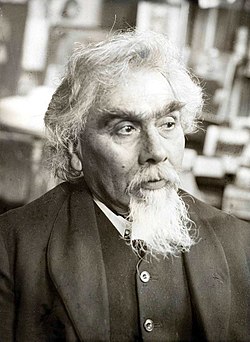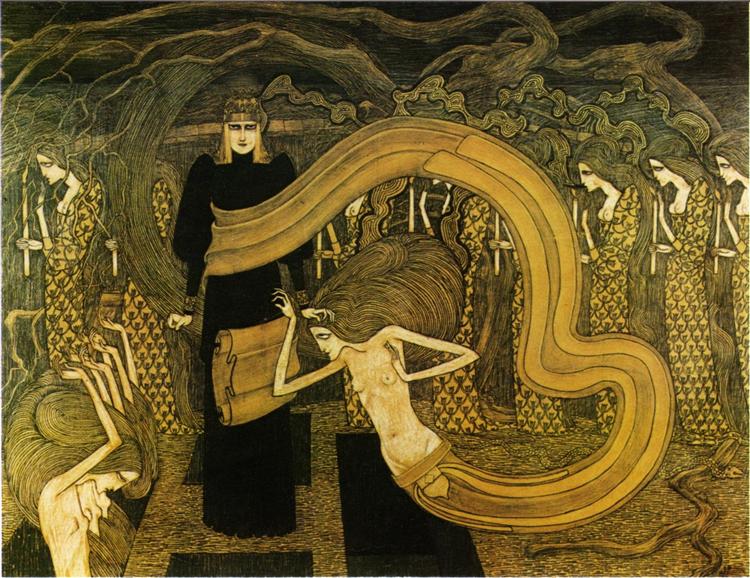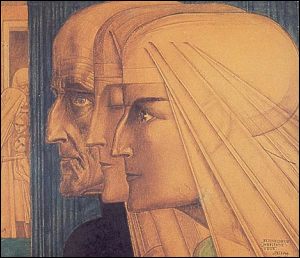Jan (Johannes Theodorus) Toorop (Poerworedjo 1858 – The Hague 1928) was one of the most important Dutch visual artists from the period 1880-1910. Wherever he went he had a great influence and was more of an example than a follower, always looking for a new challenge. And through him his contemporaries came into contact with what was happening in Belgium and France. Numerous styles and art movements can be seen in his work, from Impressionism, Neo-Impressionism, Pointillism, Art Nouveau to Symbolism. In that movement he could best express his inner feelings. His work as a draftsman and graphic artist in particular is praised for its ability to characterize the characteristics of his models. He put Art Nouveau on the map in the Netherlands with a poster for salad oil. Art Nouveau is therefore also called 'salad oil art'. In the last twenty years of his life he was strongly inspired by Roman Catholicism.

At the age of thirteen, Jan left for the Netherlands to get a better education there, while his family stayed behind in the Dutch East Indies. He stayed with three host families. First to Leiden in 1869 and in 1874 he attended the HBS in Winterswijk where he was taught by Schut, who would later also teach Mondriaan. In 1875 Jan lived in The Hague and took lessons with Herman Johannes van der Weele.
Jan was an Indo; his exotic appearance and amiable nature had a mesmerizing influence on some of his admirers. Via Delft he went to the National Academy of Visual Arts in Amsterdam in 1880 under the leadership of August Allebé. In 1882 he moved to the Academy in Brussels, with Jean-François Portaels because he thought Amsterdam was too neat and it was really happening in Belgium at that time.
His stay there would positively determine his artistic development. He shared a studio in Machelen with the symbolist painter William Degouve de Nuncques and became acquainted with the men of letters Emile Verhaeren and Maurice Maeterlinck and immersed himself in the artistic avant-garde environment, which was dominated by James Ensor and Fernand Khnopff. In 1884 and 1885 he made his first trips to France and England.
In 1885 Toorop became a member of the progressist group Les XX, Les Vingt, of Octave Maus and James Ensor as the only non-Belgian. This avant-garde association, founded in 1884, soon became a center of art, culture, literature and music for the whole of Europe and held exhibitions to which foreign artists were also invited, such as the French painters Toulouse-Lautrec, Gauguin, Signac and Rodin. exhibitions.
He went to Paris with his friend (and fellow dreamer) Ensor in 1887 and was captivated by the pointillism of Georges Seurat and Paul Signac. Toorop adopted pointillism almost immediately, albeit in his own unique way and would often put this into practice, especially in Domburg, where he would visit every summer from 1897 to 1922, and inspire others with it, including Mondriaan and Hart Nibbrig.
With Verhaeren he traveled to London in both 1884 and 1886. There he was struck by the work of the impressionist James McNeill Whistler, who was influenced by Gustave Courbet. In 1886 he married the two-year-younger Irish Catholic Annie Hall.




At that time, Toorop was fascinated by the seductive, femme-fatale, symbol of female sensuality, which destroys men. These were 'captured' with innocent women, haunted gardens with ponds and weeping willows with branches flowing down like women's hair. Death was symbolized in graveyards and skulls. Toorop's style was strongly influenced by the memories of his youth on Java with its mysterious nature and exotic vegetation, motifs from Javanese woodcarving, Japanese and Chinese fabrics and prints by the Japanese Hokusai. In the Netherlands, Toorop further developed his 'linear idealism' and symbolism in a religiously oriented Art Nouveau style. Inspired by Japanese art and nature, this movement gained a foothold in Europe.
In the summer Toorop lived in a small house on the Markt in Domburg. He worked there with painter friends, including Kandinsky, Marinus Zwart and Piet Mondriaan. Everyone followed their individual personality, but they did look for inspiration under 'the Zeeland Light'. Toorop was the center of it. He continued to visit Domburg regularly for twenty years. Since 1912, the Kotje van Toorop has been located there, now rebuilt several times, where exhibitions can be held at the time of, among others, his daughter Charley Toorop, Piet Mondriaan, Henri Le Fauconnier, Mies Elout-Drabbe, Maurice and Sarika Gòth, Ferdinand Hart Nibbrig et al.


From 1904 to 1907 the family lived in Amsterdam and there he painted landscapes and portraits in a more robust style. Increasingly in a sleek geometric style where the figures become more realistic with a strong outline. Toorop also became chairman of the Modern Art Circle and he also converted to the Roman Catholic faith, urged by his Catholic wife, from whom he actually wanted to divorce. He later received various assignments from the Roman Catholic Church. From portraits of fathers, priests and bishops, religious books, posters and stained glass windows to a Stations of the Cross.

In 1908 he left for Nijmegen (until 1916) where he met poet Miek Janssen, who played an important role in his life despite the age difference of 32 years. Toorop was inspired by her mystical Catholic background. She also served as a model for a number of Toorop's drawings and Stations of the Cross. He also illustrated a number of her poetry collections. Later they went to The Hague together. Physical discomfort became more and more common, so that he had to ride in an invalid carriage and Miek took care of him. He died in his hometown on March 3, 1928, aged 69. He was the father of Charley Toorop, grandfather of the artists Edgar Fernhout and filmmaker John Fernhout and great-grandfather of Rik Fernhout.

